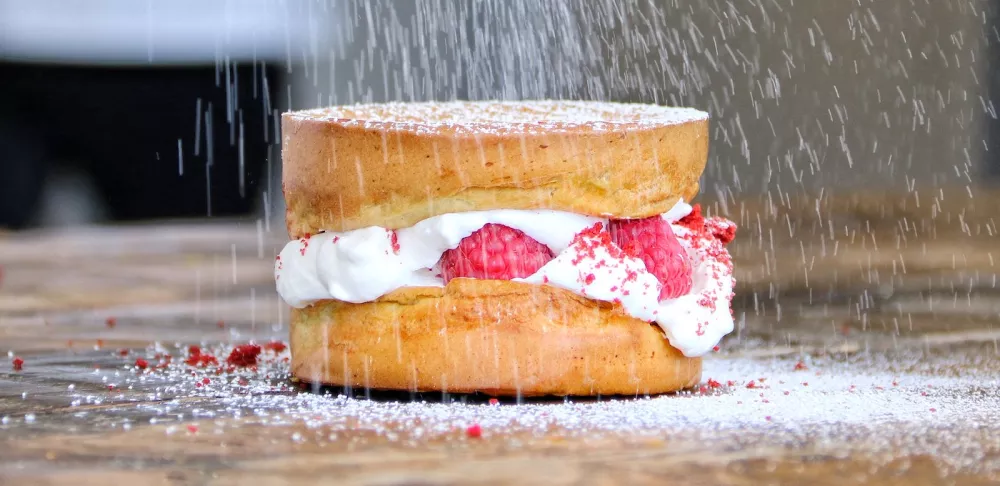 Photos by Catharina Capps
The essential pastry has seemingly endless baking applications.
Photos by Catharina Capps
The essential pastry has seemingly endless baking applications.
Croquembouche, profiteroles, beignets, churros, Parisian gnocchi, Paris-brest and gougères all have one thing in common: a deceptively simple dough like no other that creates seemingly endless varieties of deliciousness.
As a chef who is obsessive about technique, I’m enthralled by these types of recipes that seem to have endless variations and uses. By having a solid pâte à choux pastry recipe in your tool kit, you’re never without the means to make something extraordinary, taking this humble mix of flour and water to new heights.
What is pâte à choux?
Pâte à choux translates to "cabbage paste," and dates back to 1540 and the court of Catherine de’ Medici. Named for the way the small choux looks after baking, it is a relatively simple concoction with endless sweet and savory possibilities. It became notable when it was further refined by Antoine Careme for profiteroles, or rounded shells filled with ice cream.
The small puffs can be filled with pastry cream or ganache and built with caramel to form the French wedding cake croquembouche. It’s most obviously known as the dough that makes cream puffs and eclairs and is also the secret behind the delicate dumplings known as Parisian gnocchi. It can be added to mashed potatoes and fried into dumplings. Baked, boiled or fried, its signature form for most applications is a light and crispy outer shell with an open interior perfect for any sweet or savory filling. With humble ingredients at its core, pâte à choux can be easily made in any environment.
I first made this dough in pastry school and I was immediately enthralled by the magic. This simple little recipe showcases the majestic capabilities of humble ingredients, the power of gluten, the strength of eggs and the heights of steam.
How is pâte à choux made?
For the base dough, the liquid is boiled with butter and salt, and sugar as well if it's meant to be used in a sweet manner. At the rolling boil, dump all the flour in at once off the heat and stir quickly. Continue cooking over heat, stirring constantly until a skin forms on the bottom of the pot and then a minute or two longer. Transfer the dough to a standing mixer with the paddle attachment and beat until it's cool. Add the eggs, one at a time, beating until they are incorporated and continuing to add them until the paste is the correct consistency. Sounds easy, and it is, but delve deeper into each of the steps and the ingredients, and there are many discoveries to be made. There are not any other recipes made in a similar way — the only exception is a hot water crust, which is likely this pastry’s ancestor.
The ingredients — flour, water, maybe milk, butter, salt, sugar and eggs — are limited, so how each one is treated is important.
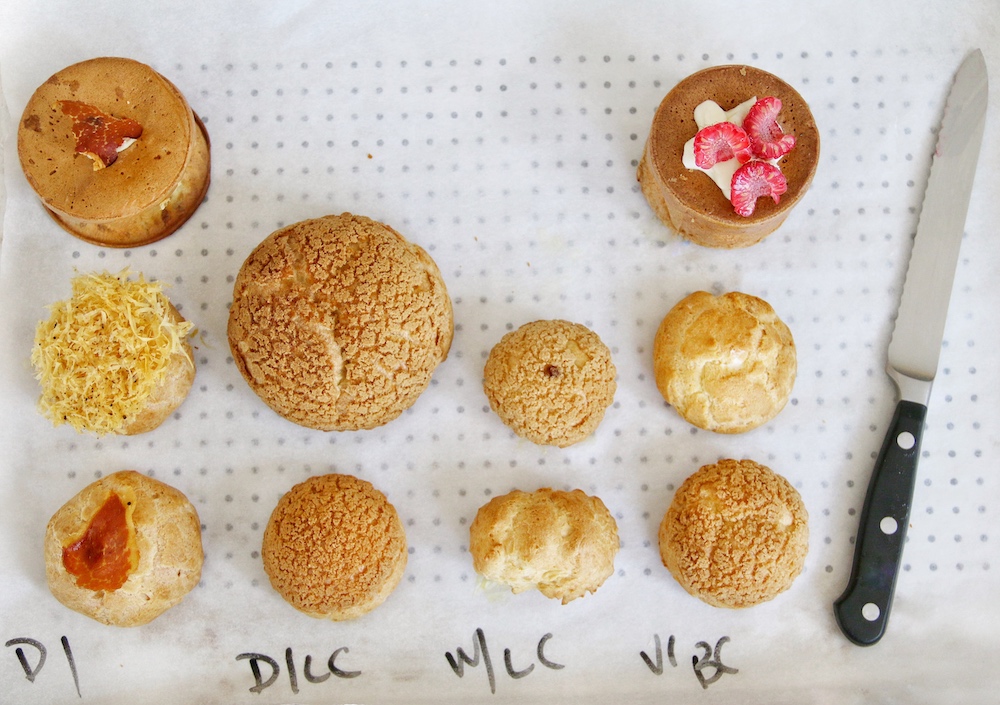
Steam is the mechanical leavener of these miraculous puffs. The liquid we use to create it is key. Standard recipes can require water, milk or both. Those that have all water will take on less color but puff magnificently. Recipes with all milk will take on a darker more enticing color but won’t puff as much because the milk encourages the eggs to coagulate faster and therefore puff less. The liquid is the first opportunity for creativity. Imagine using earl gray tea or hibiscus-infused water. My base recipe calls for equal parts water and milk to guarantee enough steam and to add some color and richness to the dough.
The butter in the recipe is for richness and flavor. Add too much fat and it will inhibit the puff. Still, even with a higher ratio of fat, you’ll get a worthy product. It’s best to cut the butter into smaller pieces so it melts more efficiently, without evaporating too much of the water needed to produce the steam.
The fat is interchangeable. One of the stellar variations I played with when writing this piece was to swap the butter for duck fat and it was incredible. It added a level of depth that worked wonderfully in my savory applications and in the sweet. Duck fat is 100% fat, unlike butter, which is 82% fat and 18% water. So when swapping out another type of fat, you need to change the amounts. Use 82% of the replacement fat that is called for in the recipe, and increase the water by 18% of the amount of butter. Since this dough is only mechanically leavened by steam, it's important to maintain the levels of the liquid in the recipe for consistent results. This is the next place where creative muscles can be flexed.
Recipes regularly call for either all-purpose flour or high-gluten/bread flour, but I’ve also encountered ones that use cake flour. When you mix wheat flour with water, gluten begins to develop. Agitate it and the gluten matrix gets stronger. Pâte à choux is a double-cooked dough, with flour first cooked in boiling liquid, developing and denaturing the gluten. My choice is for high-gluten flour, which allows for enough gluten to be developed for strength while some is lost to the denaturing without loss of structure. It’s dumped all at once into the boiling liquid to quickly hydrate and gelatinize the flour. If you didn’t dump it in all at once, it would hydrate unevenly. All at once is the way to go.
Read More:Best Flour for Baking
Salt and sugar are there for flavor, and the salt can aid in hydration so don’t leave it out. Sugar can be increased for a sweeter version or left out in savory applications.
After the liquid comes to a boil, and the flour has been added off the heat, the pot is placed back on the burner to cook it a bit further. This is one of the most important parts. You want to cook the mixture, stirring constantly, until a film builds up on the bottom of the pot. Take care not to scrape this up into your dough or you can get little unappetizing lumps. This all-important step is all about hydration. When I first learned this recipe, I was told that it was to dry it out so you could get more eggs in the dough. That is true, but more importantly, the extra cook time aids in the hydration and gelatinization of the flour, trapping more water in the dough. The more water you can trap here, the larger the expansion.
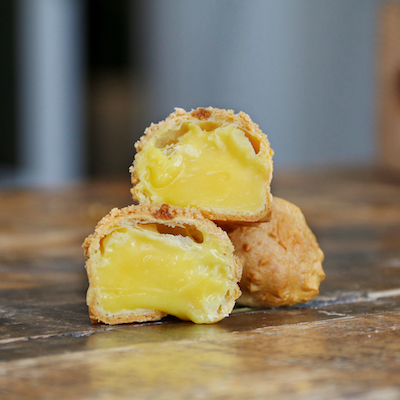 The dough gets transferred into a KitchenAid mixer and beaten on medium speed with the paddle attachment until it's cooled, so as not to cook the eggs. Once it reaches room temperature, the eggs are added one at a time. It’s best to hold back the last egg. Depending on how long the mixture is cooked and the humidity, it may take more or less eggs than the recipe calls for. You’re looking for a paste that is thick enough to hold a shape when piped but not so stiff that you can’t easily pipe it. Rather than a specific amount of eggs, there are visual cues to look for. When running a spatula through the mixture, it should readily close over itself. When lifting the paddle attachment from the mixer, it should form a "v" from the bottom of the paddle.
The dough gets transferred into a KitchenAid mixer and beaten on medium speed with the paddle attachment until it's cooled, so as not to cook the eggs. Once it reaches room temperature, the eggs are added one at a time. It’s best to hold back the last egg. Depending on how long the mixture is cooked and the humidity, it may take more or less eggs than the recipe calls for. You’re looking for a paste that is thick enough to hold a shape when piped but not so stiff that you can’t easily pipe it. Rather than a specific amount of eggs, there are visual cues to look for. When running a spatula through the mixture, it should readily close over itself. When lifting the paddle attachment from the mixer, it should form a "v" from the bottom of the paddle.
Almost all recipes call for whole eggs. In Shirley Corriher’s book, "Bakewise," she suggests a portion of egg whites. My recipe for pâte à choux now includes half eggs and half egg whites by weight. The change was dramatic. The dough was stronger, formed a more sturdy shell, and surprisingly, tasted better. Eliminating the extra fat of the egg yolks allowed the flavor from the butter — or duck fat — to shine through. The only thing I didn’t like about using the extra whites was a bit of unpredictability in puffs shaped only by piping with a round tip. But those with craquelin or frozen prior to baking were perfectly shaped. A higher ratio of egg white also made more delicious and delicate Parisian gnocchi and crullers. This version was the undeniable favorite.
Shaping the dough can be done in many forms, usually piped through a large tip. I’ve experimented with all forms of piping tips and find that the tight serrated or many-pronged open star tip provides the best structure. Pipe in one motion without moving the tip to avoid trapping air pockets. Tap your finger lightly in water and pat down any pointy tips. These will burn in the oven and take away from the beauty of the final pastry. Allow for plenty of room around the puffs for expansion when baking, as they increase in size threefold.
The most uniform pastries come from choux paste that has been piped into silicone molds and then frozen. The puffs can be baked directly from the freezer and this method creates a beautifully domed pastry.
For Parisian gnocchi, the dough is piped from a tip, cut into boiling water and cooked for only 1 to 2 minutes. The same is done for churros, but in this case, piped with a serrated tip into hot oil. For beignets, the dough can be portioned with a scoop into oil at 350˚F. And for French crullers, it can be piped on a small piece of parchment and then slid carefully into the hot oil.
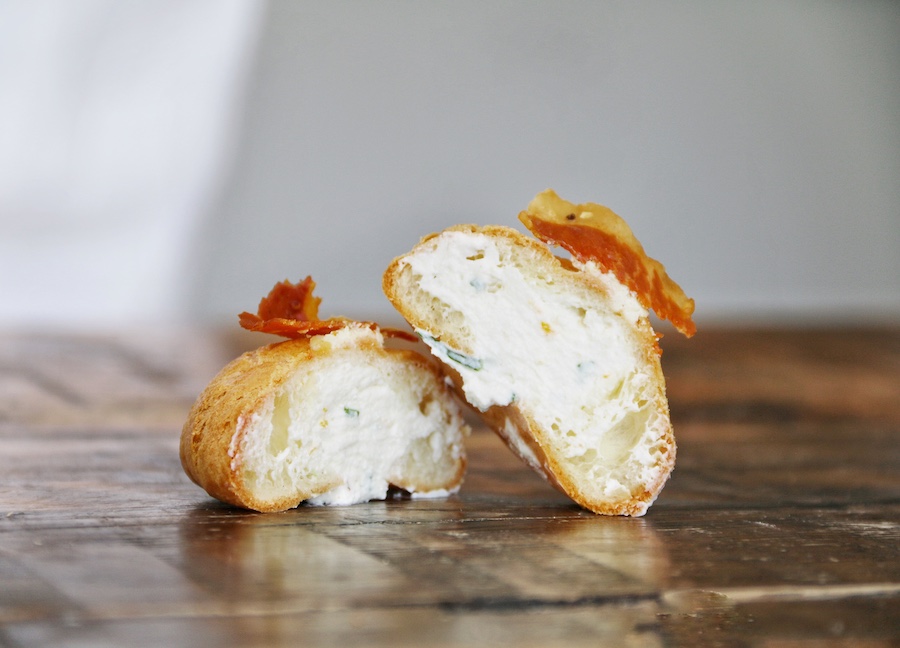
Many temperature ranges have been used to bake pâte à choux. You’ll often find directions to start high, about 415˚F, to create a lot of sudden steam to encourage puffing and then turn it down to cook through. Here at ICE, managing multiple oven temperatures with trays going in and out of the oven can be challenging, so we generally keep convection ovens about 350˚F throughout the bake time and this works well. In a non-convection oven, that would be 380-400˚F. They bake until they are puffed and dried almost completely. Take one out, and tap it on the table. Properly baked, it will feel hollow, and firm. It’s also a good idea to break one open and make sure that it is no longer wet inside. The bake time will vary depending on the size and temperature of the dough when it goes into the oven. Small sizes at room temperature will take about 20 minutes and large eclairs can go significantly longer. It's always best to have a thermometer in the oven to confirm it's working at the proper temp. Too low and the pâte à choux will never achieve its full puff potential. It’s also important not to open the oven door while it's cooking, which would let out the much-needed steam and heat, and the puffs will be cakey.
Some chefs will use egg wash to encourage browning. With the right mix of ingredients, though, it's not needed. I either spray them with a cooking spray or dust them with powdered sugar to discourage the formation of an exterior crust and keep it pliable for as long as possible while baking.
Cracking is often an issue with baking puffs. A few tricks will help avoid the dreaded cracks. Using the serrated piping tip is key. Avoiding egg wash that can hold the paste down to the parchment when baking helps as well. Oven temperature is important, too. If the puffs dry out too much before fully expanding, there will be cracks where the surface has dried.
Another issue that often occurs is collapse after removing the puffs from the oven. In this case, they were under baked and the protein structure didn’t have enough time in the oven to fully set up. Pâte à choux can also be cooled in the oven with the heat off and the door cracked to avoid collapse. A small hole poked in the bottom of each puff will encourage steam to escape and maintain the shape.
Choux with craquelin originated in Japan, where the traditional French pastry is taken to a new level. It's incredibly simple to make: Combine equal amounts of all-purpose flour, white or brown sugar, and butter in a mixer. Roll thinly between two sheets of parchment and freeze before using a round cutter to cut to a size just larger than your puff. Top each puff with a round of craquelin and bake. This method adds a lovely sweet crunch and helps the puffs keep an elegant uniform shape.
One of my very favorite uses for this dough is to create cake layers. Use a ring mold and pipe the paste in a thin layer in a concentric circle inside of the mold. Halfway through baking press it down with a spoon to take out a bit of the air. Let it cool and fill the light and delicate pastry with fresh fruit and a cream of choice to match that ethereal texture of the pastry.
Pâte à choux is truly a magical dough that can host myriad transformations. What will you do to take it to the next level?
Work with Chef Penny in ICE's Pastry & Baking Arts program.
Pate a Choux Recipe
- 80 grams milk
- 80 grams water
- 65 grams unsalted butter
- 3 grams salt
- 3 grams sugar
- 110 grams high-gluten (bread) flour
- 100 grams whole eggs
- 100 grams egg whites
Transform dough for a living with career training in Pastry & Baking Arts.
Pastry & Baking ArtsPastry & Baking ArtsDessertsICE InstructorsCakePastry & Baking Arts Step 1 - Boil water or a mix of water and milk), butter, salt, and sugar if making a sweet version in a pot until the mixture reaches a rolling boil; Step 2 - Remove from heat and add all the flour at once, stirring quickly to combine; Step 3 - Return to heat and cook, stirring constantly, until a film forms on the bottom of the pot about 1-2 minutes; Step 4 - Transfer the dough to a stand mixer with the paddle attachment; Step 5 - Beat on medium speed until the dough cools to room temperature; Step 6 - Add eggs one at a time, beating well after each addition until fully incorporated; Step 7 - Stop adding eggs when the dough reaches the desired consistency thick enough to hold a shape but not too stiff Step 8 - Pipe the dough onto a baking sheet lined with parchment paper or silicone mat; Step 9 - For even shapes, use a serrated or open star piping tip and ensure the puffs are spaced adequately to allow for expansion; Step 10 - Preheat the oven to 350°F or 380-400°F for non-convection ovens; Step 11 - Bake until the puffs are well-risen, dry, and hollow inside. Baking time varies by size, approximately 20 minutes for small sizes and longer for larger eclairs; Step 12 - Avoid opening the oven door during baking to maintain steam and heat; Step 13 - If needed, use a small hole in the bottom of each puff to release steam and prevent collapse; Step 14 - Let the puffs cool on a wire rack; Step 15 - Optionally, brush with egg wash or dust with powdered sugar to enhance appearance and prevent crust formation;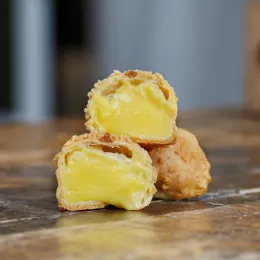


Matzo balls with this technique
Submitted by Jill Kibler on March 24, 2021 2:45am
Thanks for this great lesson! I have made matzo balls using schmaltz As the fat, water as the liquid, and matzo meal in place of the flour. The balls turn out lovely and light. I did not realize Parisian gnocchi were made in this same fashion.
Add new comment